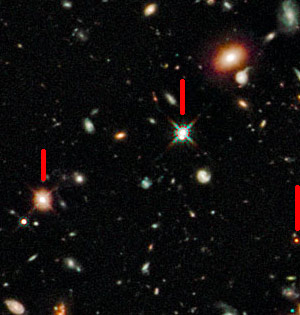I haven’t heard much from the Hubble Space Telescope folks since it was refurbished earlier in the year. Maybe that’s because they’ve been busily working on putting together an incredible image, the deepest ever taken in the near infrared. Feast upon this:
[Oh yes, you want to click to embiggen that, or grab yourself a gorgeous 4.6 Mpixel version.]
Holy Haleakala! This picture is incredible. They pointed Hubble at a fairly empty region of space, one where very few stars are seen. Then they unleashed the new Wide Field Camera 3 (called WFC3 for short) on it, taking images in infrared wavelengths just outside what the human eye can see… and they let it stare at that spot for a solid 48 hours.
The result? This picture, showing galaxies flippin’ everywhere, some seen a mere 600 million years after the Big Bang itself. Because the Universe is expanding, distant galaxies appear to recede from us, and their light gets stretched out. This Doppler Effect – the same thing that makes the sound of a car engine drop in pitch when it passes you at high speed – changes the colors we see from these far-flung galaxies, so their ultraviolet light, for example, gets stretched into visible and even infrared wavelengths. What you are seeing here is actually more energetic light emitted by galaxies that’s lost energy traveling across the expanding Universe, so by the time it gets here it’s infrared.
So the colors are not “real” in this image; they’ve been translated into red, green, and blue so we can see them. The reddest objects in the image are most likely the farthest away, and may be as much as 13 billion light years away.
Thirteen billion. With a B.
 Let me point out something: here is a zoom in on one part of this ultra deep field, from the upper left. I’ve marked three objects. The one in the middle is a star; even with Hubble stars are point-like sources. The light from the star gets bent a bit (diffracted) around the metal support structure holding one of Hubble’s mirrors in place, giving it that crosshairs feature (we astronomers in the know call them diffraction spikes).
Let me point out something: here is a zoom in on one part of this ultra deep field, from the upper left. I’ve marked three objects. The one in the middle is a star; even with Hubble stars are point-like sources. The light from the star gets bent a bit (diffracted) around the metal support structure holding one of Hubble’s mirrors in place, giving it that crosshairs feature (we astronomers in the know call them diffraction spikes).
But look, the object on the left, clearly a galaxy, has crosshairs too! And they’re centered right on the galaxy’s nucleus, meaning that galaxy has a very bright, star-like core. We see this a lot in galaxies, when the supermassive black hole that lurks at the heart of every galaxy happens to be actively and voraciously eating matter. As this material spirals in, it gets very, very hot, and emits vast amounts of light. We call these active galaxies, and they were common in the early Universe. Studying them gives us insight into what galaxies were like when they were young, how that monster black hole forms and changes over time, and how galaxies themselves are born, age, and evolve over time. How many active galaxies can you find in the bigger picture?
And that little red dot all the way on the right? It’s not possible to say for sure, but given its reddish color in the picture and the fact that it’s a tiny dot makes me think this is one of those extremely distant galaxies, an object whose light has been traveling for roughly 95% of the age of the Universe itself. Those photons have hiked for billions of light years, seen the Universe change drastically, slammed through dust and gas clouds, curved around gravitationally-warped space, all to finally fall into the waiting glass mirror of our eyes’ orbiting proxy in space.
And there are dozens of those red dots in this image, all full galaxies in their own right, shrunk in apparent size and stature by their mind-numbing distance. And there are thousands of other galaxies, too… and yet this image is small, covering an area of the sky only 1/15th the width of the full Moon – it would take 8000 30 million images like this to cover the whole sky!
That means that everywhere you look, any direction you may choose, there are thousands, millions, billions of galaxies lurking there, hidden by nearby stars, gas, dust, other galaxies, and the terrible scale of space and time of our ancient Universe.
Everywhere we look, there are treasures to unveil. That’s what science tells us. And that’s why I love it.